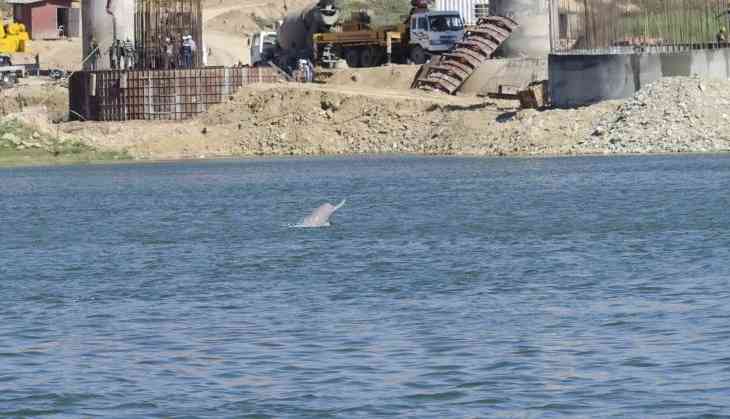The Tiger of the Ganga

It is time to remember the Ganga River Dolphin as it is Dolphin Day today-- April 14. This is all the more because, back in 2009 October, India had declared Gangetic Dolphins(Platanista gangetica), commonly known as Soon or Susu, its National Aquatic Animal—though only to forget all about it later, it seems.
Often referred to as Tiger of the Ganga, Ganga River Dolphins are an indicator species. As the presence of the tiger, the apex animal in the natural forest, is an indication of the quality of the wild, the presence of the dolphin is an indicator of the quality or purity of the river.
“The presence of dolphin in a river system suggests a healthy ecosystem. Since dolphin is the apex of the aquatic food chain its presence in adequate numbers symbolises greater bio-diversity in the river system,” observes Sandeep Kumar Behera, author of the Ganges River Dolphin Action Plan 2010-2020, who had coordinated a study of dolphins for World Wide Fund for Nature (WWF), back in 2008 in Madhya Pradesh, Uttar Pradesh and Rajasthan.
The Ganges dolphins are long-beaked, stocky, with a rounded belly and large flippers. As their eyes lack lens they are often referred to as blind dolphin; weighing around 90 kg on an average, their adult females can be identified from their longer beaks, curved upward. They are increasingly threatened after the rapid rise in the human use of the river systems, enlargement of fishing nets and the growing demand for their oil and meat as an aphrodisiac and bait for catfish.
Dolphin sighting is considered a good omen and Rajeev Tomar, a dolphin watcher and Honorary Wildlife Warden of Dholpur district in Rajasthan, found himself lucky to spot one, the other day.
The Chambal River, considered to be one of the least polluted among the Indian rivers, harbours some of the surviving Ganga River Dolphins, which are listed in the Schedule 1 of the Indian Wildlife (Protection) Act 1972. Rajeev Tomar, who was also a participant of the My Ganga My Dolphin Campaign 2015, reported to Catch News about that rather celebratory spotting like this.
“We went in a group and spotted the dolphin in the Chambal River some 500 metres upstream the old road bridge near the Dholpur town. We, as regulars to this part of the river, were hopeful of sighting a school of dolphins as near the bridge water is deep and they are spotted often,” Tomar said. The mammal was spotted —dolphins are cetacean mammals related to whales and porpoises—this time in the Chambal near Jetpur on the Madhya Pradesh side and Basai Neem in Rajakheda on the Rajasthan side of the river bank.
“Three years back I had joined the dolphin survey which was part of the My Ganga My Dolphin campaign, jointly sponsored by the Uttar Pradesh Forest Department and the WWF and supported by the National Mission for Clean Ganga (NMCG). We were in the team that surveyed the 200-km stretch from Tassod near Rajakheda and Bhare, where the Chambal meets the Yamuna in UP. We could count over 100 dolphins in the stretch,” he said.
Despite sightings, conservationists are perennially worried about the future of Ganga River Dolphins due to the deterioration of their habitat. An endemic species of the sub-continent—Gangetic Dolphins are found in the Ganga, Yamuna, Chambal, Ken, Betwa, Son, Sharda, Geruwa, Gahagra-Gandak and Rapti, in a stretch of 3,350 kms—their number is feared to be below 2000.
The Chambal river at Dholpur forms part of the National Chambal Sanctuary. If sightings of the dolphins are rare and difficult, their photography is more difficult. “They are like a mirage, at time like a meteor flashing up in the air over the water column,” notes Ravindra Singh, wildlife enthusiast and photographer. “They are not fully visible in most of the photographs. Sometimes it is the snout, sometimes it is the torso”, he points out. However, for our readers, he has got a clear photograph of the Ganga River Dolphin (see photo), taken near the Chambal bridge.
The freshwater dolphins are seemingly fighting a losing battle. The immediate danger for them in the Chambal is the decrease in the depth of the river and the increased human activity.




